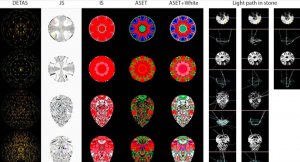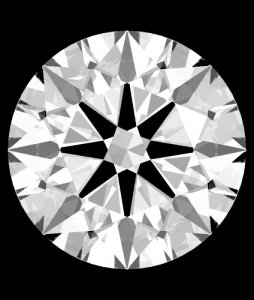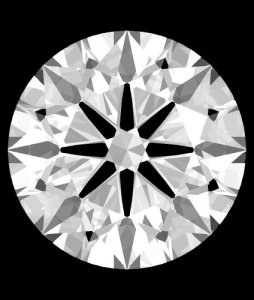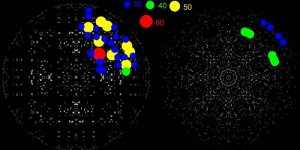strmrdr
Super_Ideal_Rock
- Joined
- Nov 1, 2003
- Messages
- 23,295
Thanks Gary. The funny thing is, before I read Serg''s post about the distributions of red and green, I wouldn''t have picked that one. I''m not saying his info is wrong, just that it got me off my normal train of thought...Date: 7/30/2009 5:22:54 PM
Author: Garry H (Cut Nut)
Ellen note the top pear has a distribution that is very strong thru the axis range but very weak from the sides - i.e. it will not pick up much light from the sides - so if you had a big window to the right and left and had the stone on a pendant - it would not get much happening. It would look great in one orientation only - and that is what the square carre (scarf) demo is all about.
Hope that helps
Yes.Date: 7/30/2009 6:00:14 PM
Author: strmrdr
One thing that many people don''t understand is you can see everything shown in an IS and ASET without the scopes.
The scopes just give you:
1: uniform lighting environment
2: it shows it all in one view
3: it is easier to see, understand and teach
Date: 7/30/2009 5:35:52 PM
Author: Regular Guy
David, to your two questions (or, make that 3 considering notes with your newest post), my bias is that it''s about bias...
That is to say...
Date: 7/30/2009 4:43:37 PM
Author: Rockdiamond
Thanks Ira.
Do we agree that the title- implying that other methods are a ''last resort'' is inaccurate?
The question I raised about picking- and how different experienced people looking at the same selection of stones with cut in mind will pick different ones- what''s the feeling about that?
1) Please do see Serg''s post, 3rd from the top, on the ''bias'' thread, page 14, here. His post motivated this thread, but since his comment had to do with the limits of reflector technology, and since you''re there already, I did want to include you. I intended the audience to be two fold...represented primarily by you and Serg, and your positions. The use of the parentheses in the title was specifically intended to allow for the fork in the road. The ''(any longer)'' part, included in parentheses because it''s optional, and did go to Serg''s fork.
2) Bias is what I think makes for subjectivity. It''s a best guess, born partly from reading here. I like to think that the possibility and actuality of cut grading is reasonable, because beauty is not highly variable, but largely predictable between people. I read that professionals get used to seeing things in a certain way, and may lose a naivete that has it''s advantages. Alternately, of course, maybe the experienced view gains in subtlety and nuance, so that is sort of tough to say. But...I do like to think that overall, cut grading is more objective than subjective, that what I like has aspects to it that can be measured, and in this way, when a professional does their job on my behalf, looking for beauty, I can without too much concern understand that their pick would be my pick. Towards this...I have been lead to understand that issues with reflector technology (IS & ASET) are besides the point, that these tools, when used properly, merely help making the objective choice, and that if the reflector choice draws one away from what I would like... (brilliant, really, that Garry''s most recent post is EXACTLY on this point) I would like to think that the mis-direction is either based on a mis-reading of the technology, or it is based on a bias in the perception otherwise.
3) With respect to low tech....technology can absolutely draw you in the wrong direction, and away from common sense. You know...in 3rd & 4th grade, they teach the kids to do estimation...because surely of this very thing. You need to trust (the technology, or whatever), and verify. But, I''ll tell ya...I don''t want a person who who simply has a confident sense of mechanics building a bridge for me. I instead want a skilled engineer, with a command of physics.
Without being experienced in viewing diamonds, unlike you, I am highly opinionated. My views are based in part on what I would like to think is correct...but also, what I find to be parsimoniously presented here, in ways I tend to find convincing. Evidence presented can lead to believability. On this board, there is a lot of data presented, providing many opportunities to cycle through and examine information in different ways.
I understand that the underpinnings of diamond beauty are based on physics, which allows cutters to repeatedly execute beauty. I think the cut of a diamond is highly correlated with beauty. I don''t think these are subjective things, no. And, I think when technology works, it helps us find that beauty in ways we can trust and rely on.
The technology is coming forward, I''m sure, as is our understanding. That''s what I think.

If you do end up buying a novo pease post pictures and the certificate stats I am very interested to know the depth of them.Date: 7/30/2009 1:24:28 PM
Author: lisa1.01fvs1
Lorelei good to be back, I can''t stay away too long.............had 2nd baby & a lot going on

Can''t one or all of you guys come with me to pick out the Novo???
Now I''m even more flumoxed (sp) than ever!!!!!
This ASET use for the novice consumer is daunting. I will certainly bring it in to T to check stones!!!
CCL - I can barely keep up with your exemplary explanations on cushions (other threads) but hope to consult you further about things. Yes I know that GOG
has sq. H&A cushions and that the pricing is also fairly steep for those.
The Novo is an upgrade and I could probably get above 1.5 cts or 1.6 in a G/VS2 or therabouts.
Thought I''d go with the patented cut this time since we are already invested so to speak & am convinced I can get a fab RB elsewhere down the line
Sorry, no idea about the NOVO, the Amorique is patented it has 70 facets thought.Date: 7/30/2009 2:51:40 AM
Author: DiaGem
Are you sure the ''NOVO'' is a patented cut.Date: 7/30/2009 2:36:30 AM
Author: ChunkyCushionLover
Date: 7/30/2009 12:15:34 AM
Author: lisa1.01fvs1
I like this thread as it has bearing on my situation a bit.
David, how would you go about asessing a patented cut fancy like Tiffany''s Novo (modified brilliant cushion)?
Garry in an earlier thread mentioned using an ASET scope to chose the best stone in specific reference to the Novo.
To quote you, ''For a consumer who has decided to take things into their own hands and decide outside a dealer''s advice- or even to re-enforce a dealer''s advice, it seems to make a lot of sense to use ASET/IS.''
Are reflectors valid for this type of stone and if so what would I be looking for? Or what should I avoid (too much green for example). (I think I''ll start my own thread on this and get more specific input.)
My instinct is telling me to go with my eyes on this one in different lighting environments if possible.
This is why Sergey''s and others'' research into the capabilities and limitations of reflectors are so intriguing to me at the moment.
The novo is close to a a square cushion hearts and arrows.
Stones like this one and others like it are cut to very exact standards and you won''t see too many like them http://www.goodoldgold.com/diamond/2106/ on this page you can see the IS. ASET and hearts viewer
If you are going into Tiffany''s to buy already set stones the best way is to use your eyes in different lighting conditions. (In a darker room, in front of the window, under the desk etc.)
Alternatively you can buy a handheld AGS ASET for $25 and go in there with it I bet they will be shocked!.
If you did look through an ASET get good back lighting and from the side and then you would be looking for the contrast of blue arrows and red almost everywherelse. The more green or background colour you saw the more light leakage.
It takes some getting used to, you have to line up the girdle of the diamond paralell to the lense and in focus.
I believe there is prior art...
It''s not.Date: 7/30/2009 7:34:53 PM
Author: Rockdiamond
I thought this was a discussion of advantages and drawbacks of different ways of selecting diamonds- and how Serg would select diamonds without the use of reflectors.
Hmm....perhaps T is trying to create greater spread with shallower cut if that''s the case. How this might influence optics is beyond me.Date: 7/30/2009 6:46:06 PM
Author: ChunkyCushionLover
If you do end up buying a novo pease post pictures and the certificate stats I am very interested to know the depth of them.Date: 7/30/2009 1:24:28 PM
Author: lisa1.01fvs1
Lorelei good to be back, I can''t stay away too long.............had 2nd baby & a lot going on
Can''t one or all of you guys come with me to pick out the Novo???
Now I''m even more flumoxed (sp) than ever!!!!!
This ASET use for the novice consumer is daunting. I will certainly bring it in to T to check stones!!!
CCL - I can barely keep up with your exemplary explanations on cushions (other threads) but hope to consult you further about things. Yes I know that GOG
has sq. H&A cushions and that the pricing is also fairly steep for those.
The Novo is an upgrade and I could probably get above 1.5 cts or 1.6 in a G/VS2 or therabouts.
Thought I''d go with the patented cut this time since we are already invested so to speak & am convinced I can get a fab RB elsewhere down the line
The ones at mayors(birks in canada) were a lot more shallow(depth %) than the cushion HA stones listed at GOG and are all within 2% of each other.
I had a really snooty and suspicious Birks salesperson look through the certificates for me and grudgingly give me the information on them.
Date: 7/30/2009 10:55:25 AM
Author: Serg
Date: 7/30/2009 10:47:44 AM
Author: Stone-cold11
Date: 7/30/2009 10:36:57 AM
Author: Serg
1) Black is Leakage + lens obscuration
2) leakage is muc more visiable in white ASET. Just compare dull green in Black ASET and with sane place in white ASET
Black ASET is more correct for cut ''grading'' than white ASET
White ASET is more useful for cut improving
3) ask ASGL or John Pollard
I thought the lens obstruction is Blue color coded?
Who could you see white, green, red in such case?
blue does not cover whole lens

I know this was brought up by Serg in the other thread and is now a couple of pages old here, but I had a question about how this affects diamond viewing. Hope it doesn't sound too stupid.Date: 7/30/2009 9:15:13 AM
Author: Garry H (Cut Nut)
Sergey also mentioned that we have 2 eyes (stereo vision) the leakage from one view can be light return from another - this is imporant.
Great point.Date: 7/31/2009 9:56:52 AM
Author: Rhino
Garry & Serg ... great stuff.
I always find it amazing & interesting where each of our research takes us after we haven''t spoken for a time. ASET can be and is helpful IMO and were I a consumer wouldn''t want to walk into a decision without that data (particularly on fancies) but what many are clueless about is how it all translates to every day practical observation. What has always been of interest to me is the DiamCalc ''darkzone'' in particular and how much *that does* translate and correlate to practical observation and why I''m a big fan of the technology Serg has developed and continues to fine tune as well as your work too Garry.
The only potential danger IMO is if we place too heavy an emphasis on telling people to ''use their eyes'' or ''trust'' this or that person is ... does that person interpret ''most beautiful'' the same way I would? What is their standard for comparison etc.? It''s one reason I''ve been turning to the means I have been recently because it demonstrates both strengths and weakness'' of reflectors yet at the same time provides a standard by which to judge.
Ira, while your question wasn''t directed towards me in particular I''ll just chime in and add this.
While I am a strong advocate of reflector based technology, I''ll be the first to tell you they are not end-all, be all solutions even in way of cut quality. As Serg & Gary has pointed out a diamond can potentially have too much darkness even when the reflector image looks great due to dynamics that the controlled environment of a reflector doesn''t take into account. This is not to mention a battery of exams we perform that go outside the realm of cut and into clarity, color and issues that can impact diamond transparency and/or structural durability.
Serg ...
Right on man.
I''ve never liked ''black'' for ASET for examining leakage. It stinks and why I''ve always used white. Another thing ... our photographic setup for ASET ... the blues are 100% 75-90 obstruction with white being leakage. No confusion between the two in our photographic setup.
All the best,

Why don''t you take an AGS0, H&A with a great ASET and or idealscope image, and make a video comparing it to a stone you picked with your own eyes that looks bad in reflector technology.Date: 7/31/2009 11:58:11 AM
Author: Rockdiamond
I think everytone agrees ''Trust me'' coming from a seller about a diamond you might like or not sounds pretty slimy.
But in fact, trust is exactly what has to develop for a person to buy.
Both stores, and websites have had to find ways of earning trust- and communicating what they find beautiful and why.
Personally I have found that photos, video and personal observations work incredibly well.... and that ASET would arbitrarily ''downgrade'' stones I have picked based on visual attributes- which is why we don''t use it.
However, even an ASET/IS needs to be interpreted using....well, our eyes, right?
Plus, consumers who have not taken the time to learn , or simply have no interest in learning the fine points of an ASET still need to trust the vendor interpreting it for them.
Again, I''m not trying to make this into a knock against reflector technology- and Ira, it''s your thread- but I really would like to know what some of the others think of the points I''ve raised here
Name of the thread?Date: 7/31/2009 12:16:05 PM
Author: Rockdiamond
I did exactly that and we had an entire thread on it...let me find it.....
Date: 7/31/2009 10:13:30 AM
Author: jet2ks
I don''t know about anyone else, but I am loving the technical aspects of this discussion. Some of it is still a little over my head (esp. some of the acronyms), but it is all interesting.
Date: 7/30/2009 9:15:13 AM
Author: Garry H (Cut Nut)
Sergey also mentioned that we have 2 eyes (stereo vision) the leakage from one view can be light return from another - this is imporant.
I know this was brought up by Serg in the other thread and is now a couple of pages old here, but I had a question about how this affects diamond viewing. Hope it doesn''t sound too stupid.
Garry, Storm and Serg, you have all mentioned hard contrast, static black zones, whatever you want to call them. How does the stereo optic view change that and how do you factor in viewing distance when looking for these? As the viewing distance increases the variation of angles between the two eyes decreases. So as the diamond moves further away, one of these zones should be both easier to detect due to the angle becoming more acute, and harder due to the eyes having to focus on a relatively smaller spot. Do you have an optimal distance for checking for these leakage areas?


Date: 7/30/2009 8:17:35 AM
Author: Garry H (Cut Nut)
Here you can see that unless there is a light dead ahead or your body is blocking lights from any illumination zones - the stone will not have the capacity to return any light from an entire suit of facets.
(this is what Sergey was referring to when he mentioned persistant DiamCalc dark zones in movies.)
We will be using video''s in tightly controlled lighting environements as an important part of our cut development work.
But this is not to say that IS, ASET and many other tools are not part of the methods employed.

